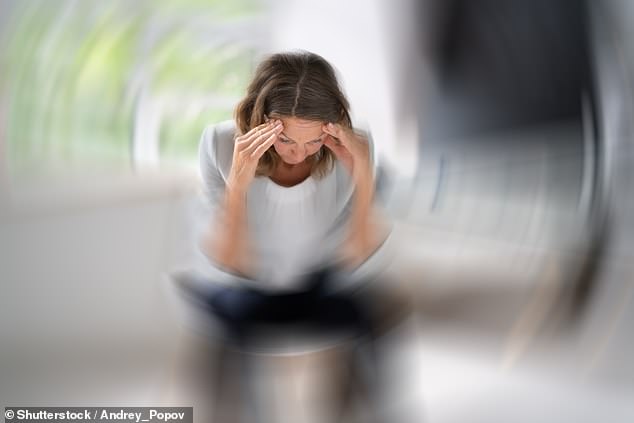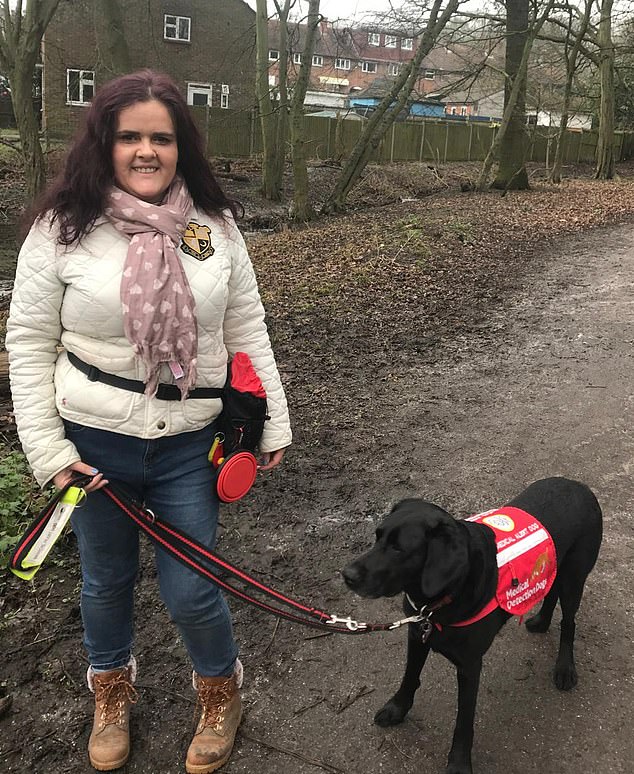For more than 20 years, mother-of-two Kerry Clayton endured dizzy spells, fainting and constant light-headedness – only to have her concerns repeatedly dismissed by doctors. Her symptoms first appeared in her teens when she fainted during an exam.
At the time, it was put down to stress. But the episodes kept happening – at work, in busy crowds – until they became, as she puts it, ‘part of everyday life’.
Despite fainting around once a week for years, repeated trips to her GP brought no answers. Because her blood pressure appeared normal in the clinic, she was simply told to drink more fluids and sent on her way.
The condition, which worsens in hot weather, began to take a toll on family life.
Kerry often had to miss holidays or turn down party invitations. She was even afraid to take her daughters, aged ten and eight, to the park during school holidays.
‘I’d have to tell them, we need to wait for Daddy to come home. It felt like I was constant letting them down, but I was scared I’d faint, especially if it was hot,’ says Kerry, a jeweller.
Then, by chance, a competition win at a business event changed everything.
Kerry, 33, won a Fitbit – a health-tracking watch that monitors heart rate – and she quickly realised it held the key to her mysterious symptoms. She noticed that when she stood up or climbed the stairs – activities that often triggered her dizzy spells – her heart rate would suddenly soar to 140 beats per minute, more than double the normal resting rate.

The dizziness and fainting caused by postural orthostatic tachycardia syndrome, or PoTS, can be debilitating, affecting people’s ability to work or enjoy daily life

Louise Thompson had been suffering with PoTS for a decade before she was forced to get a diagnosis, privately
She returned to her GP, who referred her to a cardiologist. At last the truth, she had postural orthostatic tachycardia syndrome, or PoTS.
‘It was a relief to get a diagnosis, to be honest. For a long time, because doctors kept telling me there was nothing wrong, I felt like I was going mad,’ says Kerry, who is married to Luke, 36, and lives in Rochester, Kent.
‘Though I still have symptoms, I have been able to better manage it with medication and lifestyle changes, now I know what is wrong.’
PoTS occurs when the heart rate jumps abnormally – often just after standing up – causing palpitations, chest pain and shortness of breath. Some patients also suffer shaking and sweating, headaches and fatigue.
It is linked to problems with the autonomic nervous system, which regulates the body’s ‘automatic’ functions – things we don’t consciously control, such as breathing rate, digestion, bladder and bowel function, plus blood pressure and heart rate.
Normally, when we change posture, the system makes quick adjustments to keep the pulse stable and blood flowing steadily. In PoTS, for reasons not fully understood, this process misfires.
Instead of stabilising, the heart races, bringing on distressing symptoms. It is estimated that around 130,000 people in the UK are affected, most commonly women under 50.
Research also suggests the condition has become more common since the pandemic. A University of Oxford study found a 14 per cent rise in cases in the past five years. Experts believe PoTS can be triggered by infection.
Previous studies show that more than 40 per cent of patients had suffered a viral illness in the months before developing PoTS symptoms.
The dizziness and fainting can be debilitating, affecting people’s ability to work or enjoy daily life. In severe cases, some may end up needing a wheelchair.
But experts in the condition are now sounding the alarm, as cases such as Kerry’s – where patients are dismissed, gaslit and as a result go undiagnosed for years – are becoming more common.
Despite clear NHS guidance that patients with unexplained fainting should be tested for PoTS, this often does not happen, experts warn.
Research shows sufferers wait an average of seven years for a diagnosis. And even when it is picked up, a shortage of PoTS specialists means many cannot access the right treatment. As a result, patients are often forced to pay for costly private care.
‘The system is stacked against patients with PoTS,’ says Dr Nicholas Gall, consultant cardiologist at the private Chelsfield Park Hospital in Kent and one of the country’s leading experts on the condition.
‘Too few doctors are comfortable diagnosing the condition and in some cases, hospitals without a specialist PoTS centre have been turning patients away, leading to long waiting lists and patients being left without support.
‘In my clinic, I regularly see patients who have been to a number of doctors, and told there is nothing wrong with them before they have come to me.
‘And since the pandemic, we certainly have seen an increase in demand for services. The issue is that we have no more staff able to treat the condition.’
Despite the challenges patients face in getting diagnosed, the standard test for PoTS is straightforward. Patients are asked to lie down for a few minutes and then stand up, while their heart rate, blood pressure and symptoms are monitored over ten minutes.
An alternative is the tilt table test – the patient lies on a table that can be tilted from a horizontal to a near-vertical position, while their vitals are monitored.
In either case, if there is a sustained increase in heart rate of more than 30 beats per minute in adults – or 40 beats per minute in children – a diagnosis of PoTS may be considered.
‘Part of the problem is that the typical patient is a young woman, and we have a medical system where there is a belief that young women can’t be ill, with doctors often saying that it is probably anxiety,’ says Dr Gall.
‘So the test is often not done, either in primary care or when they are referred.’
Patients with PoTS are also more likely to suffer from chronic fatigue syndrome.
Dr Gall says: ‘This is another reason why we see patients dismissed – there is a strong overlap with chronic fatigue syndrome, which is also not well understood and often wrongly labelled a psychological problem.’
Other common problems that are seen alongside PoTS include migraine, Ehlers-Danlos syndrome – a connective tissue disorder that can cause hypermobile joints, overly-stretchy and fragile skin – and fibromyalgia, a pain condition.
Treatment options for PoTS are limited and, in most cases, lifestyle changes are recommended first.
Patients may be advised to wear compression socks, drink plenty of fluids, sleep with the head of the bed slightly raised and avoid standing for long periods.
These measures all help with one of the main problems in PoTS: when someone stands up, gravity pulls blood into the legs.
Normally the body pushes it back up to the brain by tightening blood vessels and giving the heart a small boost.
But in PoTS this process does not work properly, so blood stays in the legs and not enough reaches the brain. The heart then races to compensate, causing dizziness, palpitations and fainting.
Some patients are also told to increase their salt intake, as this helps the body retain fluid and maintain blood pressure – though experts stress this advice is not suitable for everyone.
‘Once patients have a diagnosis, simple lifestyle changes can really help manage symptoms, as there are no cures for the condition,’ says Ruth Cross, a senior cardiac nurse with the British Heart Foundation. ‘However, in more severe cases patients may be offered medication.’
Doctors often turn to beta blockers – routinely used to treat high blood pressure, anxiety and heart rhythm problems – to help manage PoTS symptoms.
These work by slowing the heart rate, helping reduce the racing pulse that causes many of the problems in PoTS.
They also reduce the overall activity of the nervous system, which can be particularly helpful if a patient suffers shaking.
However, there may be fresh hope for patients.
New research suggests another cheap heart tablet, which is already available on the NHS, could be effective in relieving PoTs symptoms.
A study published last month by American researchers found that the drug ivabradine lowered patients’ average heart rates when standing and reduced the frequency of fainting episodes.
Dr Gall explains: ‘I have used this drug for a number of years. It is very effective for some patients, and as it is routinely used for other conditions we know it is safe.’
Ivabradine is already licensed for heart failure, but using it for PoTS is what doctors call an off-label prescription – when a drug approved for one condition is prescribed for another when it is discovered that it has some positive effects.
This is common in medicine,but it usually needs a doctor with specific expertise. Because there are so few PoTS specialists in the UK, many patients struggle to access the treatment, says Dr Gall.
He adds: ‘The reality is that there is not a single drug that will work for everyone with PoTS, so it is important that as many people have access to all the possible options.’
One of Dr Gall’s patients, who has been prescribed ivabradine, is Louise Thompson. The 45-year-old had been suffering with the condition for a decade before she was forced to get a diagnosis, privately.
The NHS nurse was fainting twice a day and was hospitalised for three weeks before she was diagnosed with PoTS. Now she takes ivabradine three times a day and says that has been a ‘game changer’.
Alongside the drug, she has a medical detection dog, Mercedes, who can sense and warn her when she is at risk of fainting. Louise says: ‘The only way I can describe how I felt on a daily basis, is that it was like I had too much to drink and was being spun around.
‘Without the drug and Mercedes I would be housebound, so it has been a real game changer. I have gone from passing out twice a day to maybe once a year.
‘It has allowed me to do things I never thought I would be able to do, from performing at the Royal Albert Hall with my choir to visiting Buckingham Palace.
‘I volunteer with a number of charities and I am able to live a normal life.’
Billie was ‘at war’ with her body

Like more than half of people with PoTS, Billie Eillish also suffers from hypermobility, also known as double jointedness
Pop star Billie Eilish is one of the millions of women worldwide who have been diagnosed with PoTS.
The Bad Guy and Ocean Eyes singer has said that she has been ‘at war’ with her body ever since her teenage years.
The 23-year-old, left, has a number of other health conditions, such as Ehlers-Danlos syndrome, tourettes and anxiety, which alongside her PoTS have made performing on stage a challenge. Like more than half of people with PoTS, she also suffers from hypermobility, also known as double jointedness.
‘Going through my teenage years of hating myself and all that stupid s***, a lot of it came from my anger toward my body, and how mad I was at how much pain it’s caused me, and how much I’ve lost because of things that happened to it,’ Ms Eilish told Vogue magazine.
‘I felt like my body was gaslighting me for years. I had to go through a process of being like, “My body is actually me. And it’s not out to get me”.’
Other celebrities have also shared their experiences with PoTS. These include Solange Knowles, 39, who is Beyoncé’s sister and was diagnosed in 2018, plus former Radio 1 DJ and actress Jameela Jamil, also 39, who spoke about her struggles with PoTS and Ehlers-Danlos Syndrome in 2020.
Additionally singer Halsey, 30, told in 2022 how she saw ‘100,000 doctors’ before she eventually got a diagnosis.












